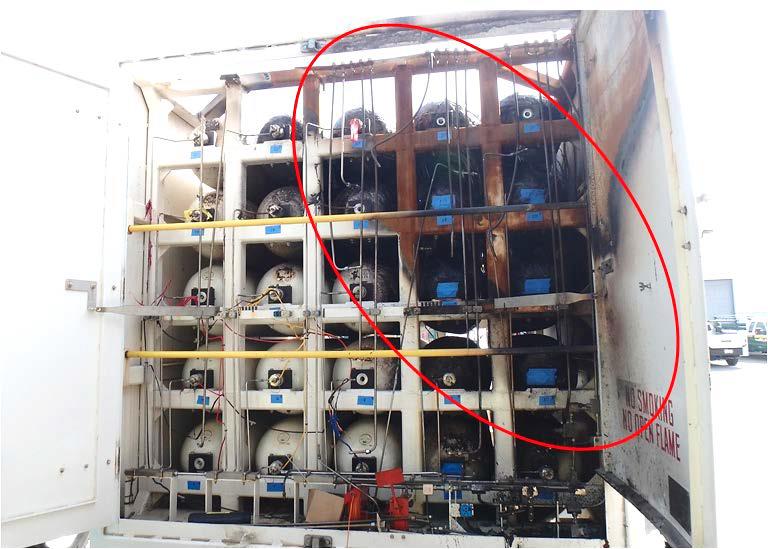No injuries were
reported in connection with the incident but approximately 1,500 people were
evacuated and resulting damages were estimated at $175,000.
An Air Products
tube trailer with a mounted Structural Composite Industries model CT-250 tube
trailer module with 25 cylinders, 24 of which were fully loaded with compressed
hydrogen, caught fire while being transported on Golden Springs Drive, Diamond
Bar. The incident happened when an incorrect pressure relief device in a
cylinder actuated. The force of the high-pressure hydrogen releasing from the
cylinder caused the pressure relief device vent tubing to eject from its
fitting and allowed a hydrogen field fire to develop inside the module.
Hydrogen is a colorless and odorless Division 2.1 flammable gas that must be
compressed and transported at high pressure for commercially useful quantities.
Hydrogen is extremely flammable, may form explosive mixtures in air, burns with
an invisible flame and may ignite if a cylinder valve is opened to the air.

(The
post-incident, rear view of Air Products module number 430003 is seen in this
image taken March 12, 2018. The area of greatest thermal damage is circled in
red. NTSB photo illustration by Paul Stancil)
NTSB investigators
determined that while the trailer module gas cylinders were subjected to a
required 5-year requalification inspection and pressure test, the testing
facility technicians installed four incorrect pressure relief devices that were
designed to activate at almost one-half the required operating pressure of
10,000 pounds per square inch. The incorrect devices were inadvertently
commingled in the facility’s inventory and went unnoticed by the inspector.
NTSB also found pressure relief device vent tubing attached by compression
fittings to seven of the module’s cylinders were not sufficiently secured when
manufactured and technicians did not inspect the fittings for securement.
The NTSB initiated
its investigation of the incident to evaluate the safety of mobile hydrogen
tube trailer modules used as fueling stations for hydrogen fuel cell electric
vehicles. As of April 25, 2018, the California Fuel Cell Partnership reported
the state had 36 open retail and non-retail hydrogen fueling stations with 28
more in various stages of planning and construction.
Based on the
findings of its investigation the NTSB issued six safety recommendations with
four issued to the Pipeline and Hazardous Materials Safety Administration and
one each to the Department of Energy’s Pacific Northwest National Laboratory
and the Compressed Gas Association. The recommendations address the need for
information and guidance on managing incidents involving fuel cell electric
vehicles and hydrogen fueling infrastructure, a requirement for requalification
inspections to include correct pressure relief devices are used and testing of
device venting equipment, the development of design guidelines for tube trailer
pressure relief vent systems, emergency responder training for hazard
recognition and firefighting involving tube trailers and fuel cell electric
vehicle fueling infrastructure and guidelines for tube trailer pressure relief
device vent systems.
To report an incident/accident or if you are a public safety agency, please call 1-844-373-9922 or 202-314-6290 to speak to a Watch Officer at the NTSB Response Operations Center (ROC) in Washington, DC (24/7).